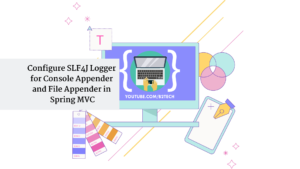Hey guys in this post, we will discuss JPA One-to-One Bi-directional mapping with Example. We will create a spring boot project step by step and connect it to the MySQL database. This is the continuation of the previous post, please follow that before proceeding with this.
Table of Contents
Complete example
Let’s create a step-by-step spring boot project and create a bi-directional mapping between the two tables. We will create a mapping between Laptop and Brand tables.
Read More:
- Check this how to write JPQL select query
- Check this how to write a JPQL delete query
Watch the video
Create spring boot project
There are many different ways to create a spring boot application, you can follow the below articles to create one –
>> Create spring boot application using Spring initializer
>> Create spring boot application in Spring tool suite [STS]
>> Create spring boot application in IntelliJ IDEA
Add maven dependencies
Open pom.xml and add the following dependencies –
<?xml version="1.0" encoding="UTF-8"?>
<project xmlns="http://maven.apache.org/POM/4.0.0" xmlns:xsi="http://www.w3.org/2001/XMLSchema-instance"
xsi:schemaLocation="http://maven.apache.org/POM/4.0.0 https://maven.apache.org/xsd/maven-4.0.0.xsd">
<modelVersion>4.0.0</modelVersion>
<parent>
<groupId>org.springframework.boot</groupId>
<artifactId>spring-boot-starter-parent</artifactId>
<version>2.4.4</version>
<relativePath/> <!-- lookup parent from repository -->
</parent>
<groupId>in.bushansirgur</groupId>
<artifactId>findbyfieldname</artifactId>
<version>v1</version>
<name>findbyfieldname</name>
<description>Spring boot data jpa find by field name</description>
<properties>
<java.version>1.8</java.version>
</properties>
<dependencies>
<dependency>
<groupId>org.springframework.boot</groupId>
<artifactId>spring-boot-starter-data-jpa</artifactId>
</dependency>
<dependency>
<groupId>org.springframework.boot</groupId>
<artifactId>spring-boot-starter-web</artifactId>
</dependency>
<dependency>
<groupId>org.springframework.boot</groupId>
<artifactId>spring-boot-devtools</artifactId>
<scope>runtime</scope>
<optional>true</optional>
</dependency>
<dependency>
<groupId>mysql</groupId>
<artifactId>mysql-connector-java</artifactId>
<scope>runtime</scope>
</dependency>
<dependency>
<groupId>org.projectlombok</groupId>
<artifactId>lombok</artifactId>
<optional>true</optional>
</dependency>
<dependency>
<groupId>org.springframework.boot</groupId>
<artifactId>spring-boot-starter-test</artifactId>
<scope>test</scope>
</dependency>
</dependencies>
<build>
<plugins>
<plugin>
<groupId>org.springframework.boot</groupId>
<artifactId>spring-boot-maven-plugin</artifactId>
<configuration>
<excludes>
<exclude>
<groupId>org.projectlombok</groupId>
<artifactId>lombok</artifactId>
</exclude>
</excludes>
</configuration>
</plugin>
</plugins>
</build>
</project>
spring-boot-starter-web dependency for building web applications using Spring MVC. It uses the tomcat as the default embedded container.
spring-boot-devtools dependency for automatic reloads or live reload of applications. spring-boot-starter-data-jpa dependency is a starter for using Spring Data JPA with Hibernate. lombok dependency is a java library that will reduce the boilerplate code that we usually write inside every entity class like setters, getters, and toString()
Configure the datasource
spring.datasource.url=jdbc:mysql://localhost:3306/mydb
spring.datasource.username=scbushan05
spring.datasource.password=scbushan05
spring.jpa.hibernate.ddl-auto=update
Create an entity class
Create Laptop.java inside the in.bushansirgur.springboot.entity package and add the following content
package in.bushansirgur.springboot.entity;
import java.math.BigDecimal;
import javax.persistence.Entity;
import javax.persistence.GeneratedValue;
import javax.persistence.GenerationType;
import javax.persistence.Id;
import javax.persistence.JoinColumn;
import javax.persistence.OneToOne;
import javax.persistence.Table;
import in.bushansirgur.springboot.request.LaptopRequest;
import lombok.Getter;
import lombok.Setter;
@Entity
@Table(name="tbl_laptops")
@Getter
@Setter
public class Laptop {
@Id
@GeneratedValue(strategy = GenerationType.IDENTITY)
private Long id;
private String name;
@OneToOne
@JoinColumn(name = "brand_id")
private Brand brand;
private BigDecimal price;
public Laptop(LaptopRequest request) {
this.name = request.getName();
this.price = request.getPrice();
}
}
@OneToOneannotation is used to add one to one relationship between two tables@JoinColumnannotation is used to join a new column, this will be the foreign key column of the tbl_laptops table@Dataannotation which is a Lombok annotation, that will automatically create setters, getters, toString(), and equals() for us.@Entityis a mandatory annotation that indicates that this class is a JPA entity and is mapped with a database table.@Tableannotation is an optional annotation that contains the table info like table name.
@Idannotation is a mandatory annotation that marks a field as the primary key
Create Brand.java inside the in.bushansirgur.springboot.entity package and add the following content
package in.bushansirgur.springboot.entity;
import javax.persistence.Column;
import javax.persistence.Entity;
import javax.persistence.GeneratedValue;
import javax.persistence.GenerationType;
import javax.persistence.Id;
import javax.persistence.OneToOne;
import javax.persistence.Table;
import lombok.Getter;
import lombok.Setter;
@Entity
@Table(name = "tbl_brand")
@Setter
@Getter
public class Brand {
@Id
@GeneratedValue(strategy = GenerationType.IDENTITY)
private Long id;
@Column(name = "brand")
private String name;
@OneToOne(mappedBy = "brand")
private Laptop laptop;
}
- To make bi-directional, inside the Brand create a reference variable for the Laptop and add
@OneToOneannotation - We will provide the option
mappedByand the value will be the name of the reference variable ofBrandinside theLaptopentity
Create a Repository
Create an interface LaptopRepository.java inside the in.bushansirgur.springboot.repos package and add the following content
package in.bushansirgur.springboot.repository;
import org.springframework.data.jpa.repository.JpaRepository;
import org.springframework.stereotype.Repository;
import in.bushansirgur.springboot.entity.Laptop;
@Repository
public interface LaptopRepository extends JpaRepository<Laptop, Long>{
}
Create an interface BrandRepository.java inside the in.bushansirgur.springboot.repos package and add the following content
package in.bushansirgur.springboot.repository;
import org.springframework.data.jpa.repository.JpaRepository;
import org.springframework.stereotype.Repository;
import in.bushansirgur.springboot.entity.Brand;
@Repository
public interface BrandRepository extends JpaRepository<Brand, Long>{
}
Create a Request class
Create a class LaptopRequest.java inside the in.bushansirgur.springboot.request package and add the following content
package in.bushansirgur.springboot.request;
import java.math.BigDecimal;
import lombok.Getter;
import lombok.Setter;
@Setter
@Getter
public class LaptopRequest {
private String name;
private String brand;
private BigDecimal price;
}
This is just a plain old java object (POJO), contains private fields, setters, and getters. This class is used to send the JSON payload from the client.
Create a Response class
Create a class LaptopResponse.java inside the in.bushansirgur.springboot.response package and add the following content
package in.bushansirgur.springboot.response;
import java.math.BigDecimal;
import lombok.Getter;
import lombok.Setter;
@Getter
@Setter
public class LaptopResponse {
private Long id;
private String laptop;
private BigDecimal price;
private String brand;
}
Create a class BrandResponse.java inside the in.bushansirgur.springboot.response package and add the following content
package in.bushansirgur.springboot.response;
import java.math.BigDecimal;
import lombok.Getter;
import lombok.Setter;
@Setter
@Getter
public class BrandResponse {
private Long id;
private String laptop;
private BigDecimal price;
private String brand;
}
These are just plain old java objects (POJOs) that contain private fields, setters, and getters. These response classes are used to send the final json to the client.
Create a Rest controller
Create LaptopController.java inside the in.bushansirgur.springboot.controller package and add the following content
package in.bushansirgur.springboot.controller;
import java.util.ArrayList;
import java.util.List;
import org.springframework.beans.factory.annotation.Autowired;
import org.springframework.http.HttpStatus;
import org.springframework.http.ResponseEntity;
import org.springframework.web.bind.annotation.GetMapping;
import org.springframework.web.bind.annotation.PostMapping;
import org.springframework.web.bind.annotation.RequestBody;
import org.springframework.web.bind.annotation.RestController;
import in.bushansirgur.springboot.entity.Brand;
import in.bushansirgur.springboot.entity.Laptop;
import in.bushansirgur.springboot.repository.BrandRepository;
import in.bushansirgur.springboot.repository.LaptopRepository;
import in.bushansirgur.springboot.request.LaptopRequest;
import in.bushansirgur.springboot.response.LaptopResponse;
@RestController
public class LaptopController {
@Autowired
private LaptopRepository lRepo;
@Autowired
private BrandRepository bRepo;
@GetMapping("/laptops")
public ResponseEntity<List<LaptopResponse>> getData () {
List<Laptop> list = lRepo.findAll();
List<LaptopResponse> responseList = new ArrayList<>();
list.forEach(l -> {
LaptopResponse response = new LaptopResponse();
response.setId(l.getId());
response.setLaptop(l.getName());
response.setPrice(l.getPrice());
response.setBrand(l.getBrand().getName());
responseList.add(response);
});
return new ResponseEntity<>(responseList, HttpStatus.OK);
}
}
Create BrandController.java inside the in.bushansirgur.springboot.controller package and add the following content
package in.bushansirgur.springboot.controller;
import java.util.ArrayList;
import java.util.List;
import org.springframework.beans.factory.annotation.Autowired;
import org.springframework.web.bind.annotation.GetMapping;
import org.springframework.web.bind.annotation.RestController;
import in.bushansirgur.springboot.entity.Brand;
import in.bushansirgur.springboot.repository.BrandRepository;
import in.bushansirgur.springboot.response.BrandResponse;
@RestController
public class BrandController {
@Autowired
private BrandRepository bRepo;
@GetMapping("/brands")
public List<BrandResponse> getAll () {
List<Brand> list = bRepo.findAll();
List<BrandResponse> responseList = new ArrayList<>();
list.forEach(b -> {
BrandResponse response = new BrandResponse();
response.setId(b.getId());
response.setBrand(b.getName());
response.setLaptop(b.getLaptop().getName());
response.setPrice(b.getLaptop().getPrice());
responseList.add(response);
});
return responseList;
}
}
Run the app
Run the application using the below maven command –
mvn spring-boot:runOpen the browser and enter the following URL –
localhost:8080/laptops
localhost:8080/brands
 That’s it for this post, I hope you guys enjoyed this post. If you did, please share this post with your friends and colleagues. Also, share this post on your social media profile. Thanks, I will see you in the next post.
That’s it for this post, I hope you guys enjoyed this post. If you did, please share this post with your friends and colleagues. Also, share this post on your social media profile. Thanks, I will see you in the next post.



Build REST API with Spring Boot and JPA [2021] – 43 One to One Bi-directional in Data JPA
https://www.youtube.com/watch?v=BCx8e9RDjB0
please share this employee and department example code